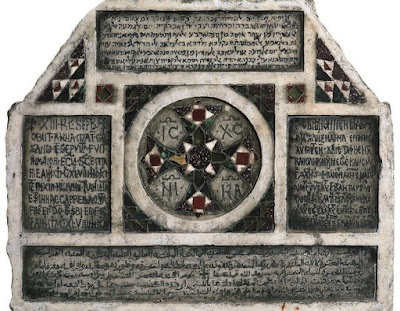Drowned Cities and forgotten empires
Jul. 30th, 2016 06:03 pmMy visit to the Potter play was on the Sunday, which, as I had to stay overnight afterwards, meant that I had booked the Monday off work and had time for a trip to the British Museum before heading home.
I went to see the Sunken Cities exhibition (which I had originally planned to see when I was in London for the Likely Stories screening, but was foiled by some protesters who caused the museum to close that day).
It's a fascinating exhibition, based on archaeological finds from Thonis-Heracleion and Canopus, cities which stood at the mouth of the Nile and which sank into the sea in the 8th Century BC. (probably due to liquefaction of the silt they were built on)
The remains of Canopus were originally spotted by an RAF pilot in the 1930s, but the discovery of the full extent of the ruins, and their identification as the near legendary cities, did not take place until 2000, when a team of archaeologists led by Franck Goddio, working with the Egyptian Supreme Council of Antiquities started to map and explore the ruins, and to recover many of the artefacts preserved there.
A selection of the finds make up this exhibition, which explores in particular the links, and the cultural connections, between the ancient Egyptian and ancient Greek civilizations. There are also other, connected items, loaned by Egyptian museums
As well as statues, finds included gold jewelry, inscriptions, buildings, ritual objects, and even a wooden barge, preserved almost intact (It's still on the seabed, I believe, but there were photographs)
The exhibition provides lots of information about the way that the Greek conquerors of Egypt adapted (and adopted) elements of Egyptian religious life, with gods from each culture being merged.
There is a fascinating section about the mysteries of Osiris, in which priests made models of the god out of a mixture of soil and seeds, and then, once the seeds had germinated, processed in barges through the canals of the city.
Of course, the water did not preserve the papyri or the amazing textiles or painted artefacts that one sees in other Egyptian exhibitions, so these artefacts seemed, to me a least, a little more distant, less relatably human, than (for instance) The Petrie, or even the items in the Egyptian galleries at the BM itself, but it's still very interesting!
I wasn't a big fan of the piped music played throughout the exhibition, which made me feel a little as if I were trapped in a New Age lift, but other than that, it think it well done. I would have liked, also, to have been given more information about the technical side of the the archaeological excavations, which the short videos presented didn't really go into.
But over all, well worth visiting!
I then headed upstairs to the old Reading room to see the smaller (and less heavily advertised) exhibition about Sicily: Sicily: Culture and Conquest.
It is absolutely fascinating, very well put together and full of beautiful and stunning things.
I admit that I know very little about the history of the island, so learned that it has been variously invaded and ruled by the Greeks, the Phoenicians, the Romans, Arabs, Normans, the Spanish and finally the mainland Italians, and of course took, and retained, elements of each culture. There are also some unique prehistoric remains, including burials.
 |
| Prehisitoric carvings |
There are some wonderful documents in the exhibition, including Arabic maps and manuscripts.
It seems that although the island was repeatedly conquered, for much of its history it was ruled by surprisingly enlightened individuals, so that the North African Arab conquerers built mosques and palaces in their own style, but allowed Christians and Jews to continue, to a gret extent, to practice their own religions and customs (albeit they were required to pay higher taxes for the priviledge, and all important posts were held by Muslims)
 |
| Christian Tombstone in 4 languages (Greek, Judeo-Arabic, Arabic, Latin - 1149) |
Then the island was conquered by Vikings, and after that buy the Normans, in 1072. (Presumably Roger I decided that Sicily was a nicer, and definitely warmer, place to conquer than England - I wonder whether he and William the Conqueror ever compared notes!
Under the Normans, the Arab culture was retained, resulting in the island being far more open and advanced both artistically and scientifically (at least in the cities, where mosques remained open, and Arab mercenaries served with Christians in the King's service. I gather rural areas were less open minded), so you get churches filled with Saracen-inspired mosaics,and a carved wooden ceiling reminiscent of those you find in the madrassas of Marrakesh. Astonishingly, given how Jews and Muslims were treated elsewhere in medieval Europe, in Sicily Jews and Muslims had freedom of religion, access to their own court.
Its a fascinating exhibition and left me wanting to visit the island, and to learn more about it!



